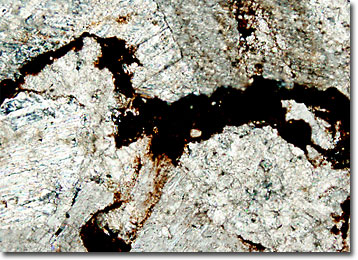Polarized Light Microscopy Digital Image Gallery
Chocolate Marble
Most marbles have been metamorphosed by heat, pressure, or other influences and are composed of at least 90 percent calcite or dolomite, though the term is often applied commercially to any chiefly carbonate rock that acquires a nice luster when polished. A broad range of accessory minerals may be present in marbles, creating an extensive range of marble types that are differentiated by color and pattern.

Despite its delicious sounding name, chocolate marble is not edible. The rock gains its confectionary-like moniker purely from its appearance, which is a characteristic deep brown. Two of the best-known occurrences of chocolate marble are found in North America, one of which is located in Tennessee and the other of which is located in Ontario, Canada. Attractive and fine-grained, the marble deposits found in these locations tend to be well layered, facilitating their natural breakage into slabs that are ideal for cutting into building stones. Indeed, chocolate marble quarried from Tennessee deposits has been utilized in the construction of many important buildings and monuments, such as the Tennessee State Capitol building and the United States Capitol in Washington, D.C.
Marble has been a valuable resource for several thousand years and was particularly heavily exploited by the ancient Greeks and Romans, who originally preferred pure white varieties, but later grew to appreciate colored marbles as well. These early civilizations utilized the crystalline rock for the construction of many impressive buildings, such as the Parthenon, and a tremendous number of fine statues. The survival of many of these ancient marble items to this day is a testament to the strength and durability of the rock.
